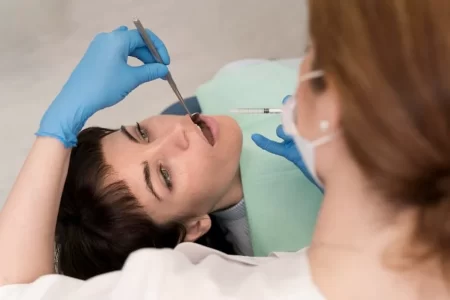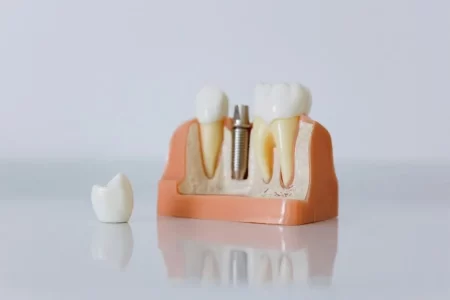What Is Edentulism or Tooth Loss?
- Updated on: Jul 15, 2024
- 7 min Read
By
- Published on Oct 2, 2019


What is tooth loss or edentulism? What are the types of edentulism?
Tooth loss is basically a process in which one or more teeth come loose and fall out. Tooth loss process is normal for babies (baby teeth), and then they are replaced by a person’s adult teeth.
Other than for this reason, if a person is losing teeth, it is quite undesirable. This may be the result of an injury or a disease, such as tooth decay and gum disease. The condition of being toothless or missing one or more teeth is called edentulism.
Edentulism types
Edentulism is of two types:
- partial edentulism: loss of one or some teeth
- complete edentulism: loss of all teeth
Tooth Loss Causes: What are the causes of tooth loss?
There are many causes of tooth loss. Some common tooth loss causes are:
Poor oral hygiene
Poor oral hygiene, which includes not brushing and flossing correctly, is the main cause of tooth loss. Poor oral hygiene makes it easier for cavities and gum disease to develop which gradually results in tooth loss.
Dental cavities
Poor oral hygiene results in tooth decay which give rise to cavities in which a substance called plaque starts to build up on the teeth. With time, plaque makes the tooth weak and eventually it falls out.
More: How Are Dental Cavities Treated?
Gum disease
Gum disease is another leading cause of tooth loss. Due to poor oral hygiene, some bacteria build up on the teeth and trigger gum disease. Gum disease can be painless, so it may not be noticed until it becomes a serious periodontal disease.
Over the years, the bone and ligaments that support your teeth may be damaged. Treating such disease can be harder if it is well established. Some of the early symptoms of the gum disease can be such as:
- Swollen or red gums
- Soreness
- Gums bleeding while brushing
More advanced symptoms when gum disease reaches its later stages may include:
- Gum infections
- Pockets or gaps between the teeth and gums
- Gum recession
- Loose teeth
- Bad breath
- Abscessed gums
- Unpleasant taste in the mouth
More: What Is Periodontal Disease (Gum Disease)?
More: How Is Gum Disease Diagnosed?
Tooth injury
During a fall, accident or contact sports, a tooth may fall out. Teeth clenching or teeth grinding also wear them down and result in tooth loss. Tooth loss is seen in people who habitually use them as tools to:
- Tear off tops, lids or clothes labels
- Crack nuts or ice cubes
- Chew on pens or pencils
- Loosen knots
- Cut off thread
Smoking
Smoking can initiate gum disease and can also make them worse. This increases the risk of tooth loss. Smoking is also a reason for a bacterial plaque that again causes gum diseases.
Poor eating habits
Excess sugar in daily diet is a sure way to ruin the oral health. Sugary foods and drinks are a chief cause of all types of teeth problems such as tooth decays and weakening the tooth enamel.
Acidic foods and drinks also cause tooth erosion and wear away the enamel. Examples of highly acidic choices include:
- Citrus fruit
- Orange or grapefruit juice
- Colas
- Alcohol
- Pickles
Medication and drugs
Some ordinary medicines like high blood pressure medications, certain procedures like chemotherapy and certain legit and illicit drugs like crack cocaine and methamphetamines can cause a lot of damage to the tooth because:
- They trigger acid in the stomach that damages teeth during vomiting
- They increases the risk of harmful behaviors such as teeth grinding or clenching
- They release acidic chemicals into the system
Chronic conditions
Some chronic (long-term) conditions can increase the risk of tooth damage and loss. Some of these chronic conditions may include:
- Poorly managed diabetes (high glucose levels in the saliva help bacteria and plaque to multiply in the mouth)
- Rheumatoid arthritis (trigger inflammation that can damage salivary glands and periodontal ligaments)
Eating disorders
Bulimia and anorexia are the eating disorders that may cause tooth damage and loss. Vomiting or acid reflux forces powerful acids from the stomach into the mouth. This acid can destroy the teeth in various ways such as breaking down enamel and causing cavities and even tooth loss.
What are the risk factors for tooth loss?
There could be various reasons and risk factors of tooth loss. The main tooth loss risk factors are given below:
- Being older than 35
- Being male
- Never getting professional dental care
- Never using a toothbrush
- Smoking
- Having diabetes
- Having high blood pressure
- Having rheumatoid arthritis
- Gum disease – front (anterior) teeth are more likely to be lost than the back teeth
More: Bruxism (Teeth Grinding Or Jaw Clinching): Causes, Symptoms, Prevention, Treatment
Tooth Loss Treatment: How is tooth loss treated?
Teeth replacement is the only solution to teeth loss in which the lost teeth is replaced by a new one. Below given are some of the more common tooth replacement options to help in tooth loss treatment.
Dental implant
A dental implant is an artificial tooth root that is placed into the jaw (location of tooth loss) to hold a replacement tooth. Dental implants are most commonly used for tooth loss treatment because they are:
- More natural looking
- More stable and typically longer lasting than many other tooth replacement options
- Helpful in stimulating the bone under the tooth, thus avoiding bone loss.
The only disadvantage is that they have a higher up-front cost.
Tooth-supported fixed bridge
This procedure of tooth loss treatment involves grinding away healthy, adjacent teeth and adding a bridge across those teeth to support the crown. But this process damages the healthy teeth.
Complete denture
This is a low-cost alternative for treating tooth loss. This procedure has some limitations, which include:
- They are recommended in the cases of complete teeth loss (complete edentulism)
- Dentures can be awkward (click in the mouth when one speaks, eats, laughs or coughs)
- Initially, they are very uncomfortable
- They limit the ability to taste food fully
- The natural bone below a complete denture may get damaged over time and this may change the appearance of smile and face
Removable partial dentures
Removable partial dentures for treating tooth loss are recommended for a patient who desires to have replacement teeth and who cannot have a bridge or fixed partial dentures.
They often have some form of clasp that attaches to the natural teeth. This holds the denture in place. Some of the limitations of this method of treatment of tooth loss are given below:
- Removable partial dentures may have stability and comfort issues
- They may also affect speech and eating
- The bone below a removable partial denture may get damaged over time and this may change the appearance of smile and face
Resin-bonded bridge
In this method, a metal or porcelain wings on each side of the bridge are attached to the existing teeth. They are a better option than removable partial dentures for treating tooth loss. Certain limitations of this method include:
- It is not long lasting
- The bone below a resin-bonded bridge may get damaged over time and this may change the appearance of your smile and face
Based on what your condition may be, your doctor can suggest a suitable tooth loss treatment option for you. Not everyone may require the same treatment of tooth loss.
More: Bad Breath Prevention: How To Get Rid Of Bad Breath (Halitosis)?
More: Treatment Options and Home Remedies for Bad Breath
Tooth Loss Prevention: How can tooth loss be prevented?
Prevention of tooth loss can be done in following ways:
Preventing tooth decay
Tooth decay can be easily prevented by following some preventative measures. They include:
- Brushing teeth at least twice a day with fluoride toothpaste
- Flossing between your teeth at least once a day
- Getting regular check-ups with the dentist
- Using mouthwash (not after brushing as it removes fluoride)
- Quitting smoking
- Changing toothbrush every 2-3 months
Read about tooth decay prevention. Preventing tooth decay can help in the prevention of tooth loss.
Preventing gum disease
Gum disease can damage your teeth. Tooth loss prevention requires prevention of any gum disease. In order to prevent gum diseases, certain steps need to be taken. They include:
- Regular appointments for a thorough cleaning and complete periodontal assessment also including X-rays
- Taking help from dental hygienist on how to effectively clean all the surfaces of your teeth at home
Preventing tooth damage
Nothing much can be done to prevent a fall or an accident that causes tooth loss, but certain steps can be taken to prevent such accidents, which will help in tooth loss prevention. They are:
- Always use a mouth guard while playing sports like rugby
- After losing a tooth, place it in milk straight away and go immediately to a dentist. If done quickly, there are chances that it can be re-implanted
Diet tips to help prevent tooth loss
There are some simple diet tips that can help prevent tooth decay and ultimately in the prevention of tooth loss. They include:
- Chewing sugar-free gum after eating or drinking can stimulate saliva that will protect the teeth
- Brush at least an hour after eating or drinking anything
- Eating foods rich in vitamins and minerals
- Eating five portions of fruits and vegetables in a day
- Eating a small piece of cheese after a meal to reduce the acidity in the mouth
- Avoiding sugary foods
Fixing gaps
Missing tooth can put a strain on remaining teeth either side and create a gap. This gap between teeth can affect the bite.
Food particles can get stuck in gaps, causing further tooth decay, gum disease and tooth loss. To avoid further tooth loss, gaps need to be fixed in time.
Options available for fixing the gap include:
- A fixed bridge
- A crown
- A partial denture
- Dental implants
You should consult your dentist to help him guide you about prevention of tooth loss in your case.
More: Basics of Dental Caries (Tooth Decay and Dental Cavity)
Tooth Loss Complications: What are the complications of tooth loss?
Tooth loss can have a variety of complications. Commonly observed tooth loss complications are discussed below:
Shifting teeth
Tooth loss results in tooth shifting and the existing teeth slowly migrate toward the opening. This shifting can result in a dramatic change in the organization of the teeth. This is a common complication of tooth loss.
Jaw deterioration
Tooth loss, if happens for more than one tooth, may result in the deterioration of your jaw. The jaw can be protected by choosing dental implants as tooth replacement solution.
Problems with day-to-day life
Tooth loss can result in many problems and complications, including:
Anyone in need of tooth replacement knows that eating food becomes a challenge, so your diet becomes limited. Speaking with others becomes difficult and sometimes embarrassing. Replace your teeth and your confidence and ability to enjoy life will be restored.
Speech problems
Based on the position of the missing tooth or teeth, the patient may experience problems with speech. Speaking becomes difficult and embarrassing.
Chewing problems
A patient with gaps between teeth may have trouble chewing food. Eating food becomes a challenge and so the diet becomes limited (softer foods).
Cosmetic loss and social embarrassment
Losing teeth can result in a cosmetic loss as it changes the appearance of the face. Also, some people find it embarrassing to laugh publicly.
Depending on the severity of the condition, one may suffer with one or more of the above mentioned complications of tooth loss.











